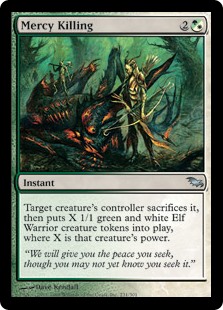As a decades-long veteran of multiplayer Magic, one of my most signature deck building preferences – particularly when it comes to EDH – is choosing which cards to include that serve a multitude of different scenarios.
This isn’t to say that every card in your deck has to serve more than one purpose. Far from it really. After all, there’s always copious choices to be had of cards you’ll want to include that are powerful, thematic, or entertaining that do just one thing particularly well. Nor is there anything wrong with that. You want cards that are going to give you the best impact for their use. They allow your deck to function and be formidable for specific applications. That is also the typical status quo for any given Magic card; the number of singular purpose cards far outweigh those which innately provide more than one.
It also makes sense when you think about it: if every card focused on a multifaceted approach, the game would ultimately suffer because of it. Cards would become less memorable. Decks would be more interchangeable. Strategies around winning would be far less interesting and creative. Stores wouldn’t be able to gouge for the pristine tourney build cards. Et cetera.
Having focused cards ensures that everyone is able to tailor and structure a deck to perform in a specific way. This allows some decks to be more adept at performing one task over another, all in the hopes that your specialization can best the angles of the other players present. Sure, you can run into situations where another player’s deck completely counteracts yours, but that’s a calculated risk nearly every Magic player accepts when sitting down at the kitchen table.
That all being said, there is an innate advantage in multiplayer settings, where you’re having to deal with an ever-changing table state and the politics therein, of utilizing cards with more than one tactical option. Some of these cards are created with that express purpose, such as the numerous ‘charm’ and ‘command’ cycles. Others provide accidental opportunities, perhaps due to the format they’re being used in or if another card alters the function of its original purpose.
And then there are cards like this week’s pick, that beg the question: which angle was its true original purpose exactly?
Today we have: Mercy Killing

Name: Mercy Killing
Edition: Shadowmoor
Rarity: Uncommon
Focus: Creature Spot Removal / Token Generation
Highlights: Mercy Killing is one of the more iconic elf cards from the Lorwyn & Shadowmoor blocks, reflecting the storyline inversion of the dark, cold, and antagonistic elves into the more modest and empathetic elves you tend to see in a Magic setting. In this case, Mercy Killing is not an ironically named card. Instead, its flavor depicts an earnest desire to put another creature out of its perceived misery emanating from a desire to help more than anything else.
Similar to its uncommon flavor, the text to Mercy Killing is also rather strange for spot removal. Although not entirely unique per se, the card isn’t straight up destroying a creature as you see in most Black spot removal cards. Instead, it forces the creature’s controller to sacrifice it. The implications of this are important for a number of reasons, but the most impacting one is that (so long as the creature is targetable), it guarantees that it will be killed off. This allows you the highly economical means to take out creatures with Indestructible, Regeneration, or other abilities that may prevent it from being easily picked off. The forced sacrifice move can be quite advantageous – especially in Commander settings – and Mercy Killing easily demonstrates why.
No matter how you choose to interpret the card’s original meaning, as if it were some kind of Green / White impressionist painting with arrows, Mercy Killing is used for board control purposes. For just three mana, you’re able to easily kill off any creature on the battlefield you may have a problem with. For smaller creatures that need dying, the tradeoff of turning the target into a series of 1/1 tokens will be well worth it at any stage of the game. Larger lumbering creatures may be less ideal – is ten 1/1 creatures inherently less dangerous than one 10/10? – but if that creature is something you otherwise may not be able to easily handle, Mercy Killing provides a handy answer in a color scheme that rarely gets unrestricted creature removal.
The flip side to its use is to cast this card on an otherwise already doomed creature of yours. That is, Mercy Killing can also be used to kill off your own creature already destined to die so that you can turn losing your own creature into a series of token creature replacements. If another player is trying to destroy your creature, or if it’s guaranteed to not survive the current round of combat, Mercy Killing lets you claim something positive from an otherwise unfortunate situation.
And then there’s the hidden third benefit, which is that Mercy Killing can allow you to create a series of token creatures in a pinch by willingly offering up one of your own otherwise healthy creatures, giving you the option for a series of instant-speed tokens to be used as needed.
No matter case, Mercy Killing is well worth its mana investment. With the ability to use it on offense, defense, and in situational settings, it’s precisely the kind of Commander card that can slide into decks without a lot of thought. For no matter how you decide to utilize it, you’re almost always going to benefit in the end.
Keep an eye out for us to be regularly featuring other more accessible-but-worth-it Commander cards going forward. In the meantime, we’ll keep the light on for you.
![]()
You can discuss this article over on our social media!
